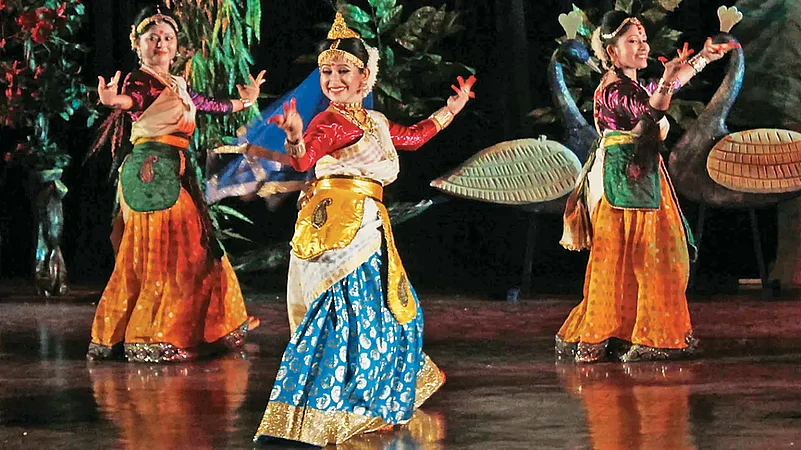In the 1980s, like the rest of India, in Mizoram, the Sunday morning, which is also the ‘church morning’, came to a standstill when the entire families staying glued to their TV sets for an hour. The TV serial Ramayan grabbed eyeballs of the non-Hindi Mizo population, which was in a transitional phase from pre-Christian to Christianity. So much was its popularity that playing with bows and arrows became a favourite sport of the Mizo kids. In an attempt to stop Hinduism from influencing the tribal land, the Church asked parents to not let their children indulge in the sport.
But much before the serial, the Mizos had their own versions of the Ramayana in their folklores known as “Khena leh Ramate unane thawn thu” (The story of Khena and Ram)”, where Khena is the name for Ram’s brother Lakshman.
For the Mizos, a native tribe of Mizoram and surrounding regions of Myanmar, Lord Rama is the God who taught them how to cultivate rice. Like Khena and Ram, there are localised versions of the Ramayana among different tribes of the Northeast. Just like the Lam Sadok in Laos, among the Tai-Phake tribal community of Assam, Ram appears as a Bodhisattva, while Sita is a weaver in the Bodo version.
ALSO READ: Who Is Ram And What Is His Story?
In Manipur, Ram wanders through Wari Leeba–story telling, Pena-Sakpa (ballad singing), Khongjom parba (narrative singing accompanied by dholak) and Lairik Thiba-Haiba (folk theatre), among others. The Karbis have their own version of the epic called Sabin Alun. They believe they have descended from Sugriva, the King of Kishkindha, who helped Ram find his consort and eliminate Ravan. Here, Sinta (Sita) emerges out of a peahen’s egg rather than the earth. Similarly, the Khamtis of Arunachal Pradesh have Lik Chaw Lamang, while the Jaintia, Khasi and Garo tribes of Meghalaya have their own versions of the Ramayana.
There are several such versions of Ram Katha or the tales of Lord Rama that flow through the folklore, cultural traditions and traditional religions in the Northeast. It is written and rewritten, told and retold, adapted, translated and appropriated in various localised forms adding and subtracting plots and subplots. Speaking to Outlook, Ananya Barua, associate professor with the Department of Philosophy in Hindu College, Delhi University, says, “The Ramayana is not one fixed text of all time. It belongs to all and everyone has their local way of interpreting and reinterpreting the epic. In many tribal Ramayanas, Surpanakha takes a front seat and Sita the back one.”
ALSO READ: Who Is Ram? Defining The Enigma

While most of the tribal versions have adaptations of the original epic written by Valmiki, with Ram as a legendary hero, a more subaltern and feminist version of the Ramayana can be found among certain tribal communities. For instance, the Ramayan Kharang of the Tiwas, an ethnic community found mainly in Assam, Meghalaya and parts of Arunachal Pradesh, narrates the suffering of Sita after she is banished. When Sita gives birth to two sons, Ram visits them while she was sweeping the courtyard, and upon finding her husband and brother-in-law in her presence, Sita throws rubbish at them to express her indignation.
According to Saurav Sengupta, associate professor of Damdama College in Kamprup, Assam, the Ramayan Kharang reflects on the women in matrilineal tribal societies of the Northeast, who are free spirited, enjoy gender equality and possess the courage to protest against wrongdoings of a powerful figure. Sengupta says, “Ramayana in the Northeast is modulated around the figure of Sita as Shakti, the active female principle, and so offers a counter-reading to the north Indian texts woven around the figure of the male protagonist.”
In many tribal versions, certain characters and events of the Valmiki Ramayana change according to the culture, tradition, ecology and the animistic faiths. Hence, they become more of a cultural metaphor than sacred texts. One such example is the Sabin Alun, which is composed of Ramayana songs. The Karbis, who live in the hills and valleys of central Assam, trace their origin to Treta Yuga. They believe that during the Ram–Ravan war, the Karbis used to carry Ram’s arrows (kar). Hence, they were called Karikiri from which the Karbi came into vogue.
Sabin Alun has Janak as a farmer who lives in a makeshift hut atop a tree to monitor his fields. Sita, his daughter, is born out of a peahen egg kept in a khaloi, a traditional container used to collect fish. Like a regular Karbi girl, Sita brings water in bamboo basket on her back, weaves clothes and is good at brewing harlong, the rice beer. According to the legend, Ram stays at Janak’s place and helps him with jhum cultivation, a traditional farming practice of the Northeastern tribes. “There are various versions depending on the local expertise. The tribes of the Northeast had migrated from different places at different times and brought their own versions,” Barua adds. The Mizo version of the tale describes Lushariha (Ravan) as having seven heads instead of 10. Here, Ram and Khena (Lakshman) are twin brothers, who are included in the Mizo pantheon of Gods, regarded as the creators of rice plant and are remembered in prayers before every plantation season.
In his paper, Elective Affinities: The Influence of Ramayana on Mizo Religion and Culture, published in the proceedings of the Indian History Congress, eminent scholar and writer Sujit K. Ghosh writes, “The Mizo Rama tales contain a number of interesting features in variance with the original Valmiki Ramayana. It appears that the source of the Mizo version of Ram’s story had a non-Valmiki origin. It is evident that the non-Valmiki version, including the Buddhist one popular in South Asia—in which Sita is described to be placed in an iron box—has direct links with the Mizo version. This view further substantiates the fact that the story of Rama has not reached out to the Mizos from the mainland. Therefore, there is very little acculturation.”
The story, which takes various forms like Lairik Thiba Haiba, Wari Leeba, Khongjom Parva, Sumang Leela and so on, traversed into the Manipuri society through folk oral and performance traditions. The Manipuri version is an adaptation of Krittibasi Ramayana in Bengali, translated in the 18th century by Manipuri ruler Meidingu Garibniwaz, who introduced Ramanandi Hinduism. It exhibits the flavour of the soil of Manipur perfectly aligning with the Vaishnavite culture.
ALSO READ: Lesson On Environment From Ramayan
In Meghalaya, another northeastern state, much before the Ramayana was translated into tribal languages, the tales of the epic were popular among the tribes. The War community in the Ri-war area, which is famous for producing oranges, believes that Lord Rama had brought them from Sri Lanka. Translated from the Valmiki Ramayana to Assamese by Madhab Kandali, Saptakanda Ramayana was written in the 14th century upon the request of the Kachari king Mahamanikya (Mahamanikpha, 1330–70). The basic difference in this version—the oldest Ramayana in a modern Indo-Aryan language—is that while the Valmiki Ramayana holds Ram someone as heroic, the Assamese version humanises both Ram and Sita.
(This appeared in the print edition as "PLAYING SECOND Fiddle")


























